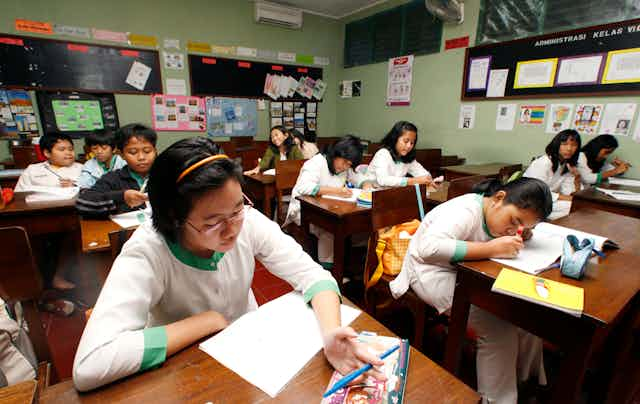Indonesia’s result in the OECD Program for International Student Assessment, or PISA 2015 report, shows some improvements in the skills of students. In particular, girls are performing better than boys in all subjects: science, literacy, mathematics. They are significantly better in reading.
From 72 countries and economies reviewed every three years, Indonesia ranks 62nd, a slight improvement compared to 2013. Indonesian students ranked the second lowest in the 2013 PISA ranking (71), worse than their ranking in 2009, when Indonesia ranked 57th.
The improvement of girls’ performance has helped to lift Indonesia’s ranking. But, overall, the performance of Indonesian students (girls and boys) in science, mathematics and reading is one of the lowest among PISA-participating countries with an average ranking of 62 out of 69 countries. (Three of the 72 assessments involved city groupings: Buenos Aires (Argentina), Beijing-Shanghai-Jiangsu-Guangdong (China) and Hong Kong (China).)
The score difference in the test in science, mathematics and reading between the 10% of Indonesian students with the highest scores and the 10% of students with the lowest scores is one of the smallest among PISA-participating countries. Indonesia’s average ranking across the three subjects is 65th out of 69 countries.
Inequality and school performance remain an issue in Indonesia. The percentage of low performers in science among disadvantaged students is among the highest globally. Indonesia ranks ninth among the countries on this measure of inequality.
Indonesian students overall do not seem to value or see opportunities in becoming a scientist. Only a small share of disadvantaged and advantaged students in Indonesia expect to pursue a career in science compared to other countries participating in PISA. Among the few who want to pursue a career in science, Indonesian girls are significantly more likely than boys to want a science-related career.
Assessing students’ ability to apply knowledge
For the PISA report 2015, 540,000 students (representing about 29 million 15-year-olds) in 72 participating countries and economies sat the test.
PISA focuses on core school subjects such as science, reading and mathematics. It does not assess whether 15-year-old students can reproduce knowledge in those subjects. Instead, PISA assesses the extent to which students who are getting near the end of their compulsory education “have acquired key knowledge and skills that are essential for full participation in modern societies”.
The underlying assumption of the PISA testing is that “modern economies reward individuals not for what they know, but for what they can do with what they know”.
The findings are a rigorous and systematic source of evidence that is meant to “provide evidence to policymakers about the knowledge and skills of students in their own countries in comparison with those in other countries … it can help countries to learn from policies and practices applied elsewhere.”
The top five countries in the PISA ranking are Singapore, Japan, Estonia, Chinese Taipei and Finland.
Do students from high-income countries perform better?
The PISA results show that students in high-income countries and economies do not necessarily perform better. Vietnam ranks eighth, higher than Australia and other OECD countries.
While high-income countries and economies (with per capita GDP above US$20,000) have more resources to spend on education, what seems to matter most in terms of quality and equitable education is the management of educational resources and the quality of teaching.
The PISA report states:
“When teachers frequently explain and demonstrate scientific ideas, and discuss students’ questions, students score higher in science and have stronger beliefs in the value of scientific enquiry and are more likely to expect to work in a science-related occupation later on.”
In the case of Indonesia, the resources are there. Education dominates social spending and 20% of the budget has to go to education.
The PISA Report 2015 has found that Indonesia’s quality of schools’ educational resources is one of the highest (fourth out of 69) among PISA-participating countries and economies. Having said that, this does not mean that schools in Indonesia have all that they need. Some regions are still poorly equipped.
What does this mean for Indonesia?
Primary and secondary education is the foundation of the Indonesian knowledge sector. Primary and secondary schools have to equip students with the analytical and critical thinking skills required to become scientists. They also have to inspire students to want to become researchers in any field.
The PISA results show that Indonesia is still struggling. Without skilled students leaving compulsory education, Indonesian universities will not be able to expand and strengthen their research programs and improve their international standing.
The private sector will struggle to compete internationally in knowledge creation, thus making it more difficult for Indonesia to transition to a knowledge-based economy. Fewer scientists and researchers means less knowledge and research is available to inform policy decisions.
The PISA Report 2015 shows only a slight improvement in the skills of Indonesian 15-year-old students. This does not correspond to the amount of resources that the government invests in education.
In August 2015, at the International Conference on Best Development Practices and Policies organised by Indonesia’s Ministry of National Development Planning, Michael Woolcock, lead social development specialist at the World Bank, said in his keynote speech that middle-income countries like Indonesia have solved the “development 1.0 problems”. Schools have been built, key legislation and polices are in place, teachers have been recruited in large numbers and data are being gathered and analysed.
The solution to the problems highlighted in the PISA report 2015 is not more resources. Rather, we need to use existing resources more efficiently.
This is a development 2.0 problem. There are no blueprints or grand solutions to these problems.
More likely, Indonesia needs thousands of small answers informed as much as possible by good-quality research into what the problems are, what works, what does not work (and why).

